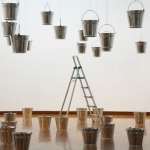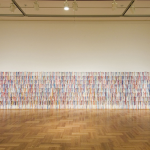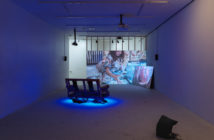Till September 19th, the New Museum in Manhattan has a mid-career retrospective for Brazilian artist Rivane Neuenschwander. The works gathered in A Day Like Any Other Day are transitory moments collected and framed. She transforms seemingly random actions into objects that capture the imagination. It is free from the controversial questions surrounding recent New Museumexhibitions. This exhibition is deserved, as it is a timely review of one of the clearest voices to emerge in our generation.
After world war II, Ernst Gombrich started his book The Story of Art with this puzzle: “There is no such thing as art. There are only artists.” Neuenschwander expands this notion by demonstrating that there are no such things as artists’ materials, only artists. Some of her better-known works, I Wish Your Wish (2003), Rain Rains (2002), and Walking in Circles (2000), are here in the exhibition and exemplify this notion.
In its third iteration in as many different countries, I wish... greets visitors in the lobby. This installation is a wall of ribbons with wishes printed on them. Visitors are asked to leave a wish behind in person or online (http://www.newmuseum.org/rivane/) and some of those wishes will be printed in the next iteration of the work. In this work, she actively pursues connections to people and their fears and dreams. She explores the unachieved, what we lack in our lives by asking us to ask for whatever we want.
On the fourth floor of the museum we find Rain Rains, a group of approximately 30 buckets with nails in the bottom that drip water into buckets below on the floor. This delightful installation activates the space with the sound of water drops. Random but sonorous, it is hard to separate the experience of Rain Rains from Walking in Circles. Walking... is a group of circles made of invisible glue on the floor. As the audience circulates through the space the glue picks up the dirt of the visitors’ feet. As they are both situated in the same space, when you start considering the decaying floor and its rings, you hear the buckets making their music and experience it without using your eyes. This cross-installation relationship works well, as it allows the viewers to project themselves into where and how the circles on the floor came to be while absorbing the non-visual information from the buckets.
Surrounding these two installations are After the Storm (2010), twelve new works made of distressed paper. In response to showing in New York, Neuenschwander exposed maps of New York's counties to a rainstorm. The paper's remaining pulp was then attached to a wooden support and drawn on with ink and acrylic paint. Not much survives of these once informative orthogonal layouts. The maps’ power to delineate how things logically relate to each other has devolved into ornate, inviting explorations of space. They’re useless now. The only thing left is an attractive, abstract exploration of the places they once depicted.
Hovering above the circles of dirty glue, ineffective distressed maps, and leaking buckets is another unusual artwork-- A clock with no time. While nursing her youngest child Neuenschwander was staring at a clock for what felt like an eternity, waiting for it to change, and she had a realization that there is only now. She made A Day Like Any Other (2008) so we can spend time looking at a clock that never changes.
At a Certain Distance (Ex Voto Paintings) (2010), 14 modest sized paintings of backgrounds from religious offerings are presented on the third floor. Coming from a newer and more visually predisposed series, At a Certain Distance is one of the only works made of traditional art media in the entire show. With the religious symbols and referents to miracles or grace removed, the interior spaces are all that remains. Their visual narrative evolves the longer they are contemplated, in the same way that older religious paintings (El Greco or Rembrandt) refute simple interpretations with ancillary secular themes. While the other works are easily rendered into words, these paintings are taciturn, even eccentric.
There are nine vitrines filled with Involuntary Sculptures (Speech Acts) (2001- 2010). Neuenschwander found these small sculptures in bars in their finished state. Unacknowledged drinkers presumably made them subconsciously while at the bar. These psychologically loaded everyday objects are as random as the One-Thousand and One Possible Nights (2008-2010). Neuenschwander made confetti from the pages of the book after which the work is named, and arranges the pieces on black paper supports. These collages form what seem like constellations from a distance. Up close, the remains of the book’s text are scattered everywhere, hinting at Scheherazade's ability to break off her stories every evening in order to remain alive for another day.
The 1001 Nights… collages differ from the sculptures as the constellations of text are formed by random chance whereas the sculptures are a deliberately selected bricolage. Both rely on an ambivalent attitude towards random formation, as does The Conversation (2010) an installation inspired by Francis Ford Coppola's 1974 movie of the same name. Neuenschwander had a number of bugs, audio recording devices, hidden behind the walls and floor of the gallery by a security company. The day prior to the exhibition's opening, she hunted down the bugs and the resulting noise of her search is being broadcast through tiny speakers where the microphones were located. The soft scratching is loudest wherever she was digging, but you can still hear the ripping carpet (saved in a pile to the side of the installation) as the artist scrutinizes the space for this intrusive technology. It's a fun and paranoid dystopian fantasy.
The most immediate and yet intellectually rewarding work presented is The Tenant (2010), a fascinating ten-minute video of a soap bubble wandering through an apartment. Alone, this soapy bubble dawdles through the space, which appears to be a recently painted apartment, as the floor is covered with newspaper and all the electrical switches and plugs are covered with tape. The initial quizzical encounter with the bubble raises questions about what went into making this video. The assumed simplicity evaporates quickly, leaving the entire video and installation feeling like a bubble itself. It is not just the soap and water that are in suspension; the entire experience as constructed for the viewer hangs in alert suspense.
Rivane Neuenschwander’s work resists the status and luxury now surrounding the museum in gentrified SoHo, needing nothing more than a few everyday things to hold our attention. Her work also resists the academic categories so often found in all art contexts and instead gains access to the museum through a combination of simplicity and ingenuity. Neuenschwander’s use of common materials in a museum setting is uncommonly fun to be around, bringing a kind of joy to the New Museum that is so often missing from exhibitions anywhere.
- Rivane Neuenschwander, Rain Rains, 2002. Aluminum buckets, water, steel cable, ladder, dimensions variable. Installation view, Hiroshima City Museum of Contemporary Art, Hiroshima.
- Rivane Neuenschwander, I Wish Your Wish, 2003. Silkscreen on fabric ribbons, dimensions variable. Installation view, St. Louis Art Museum.
- Rivane Neuenschwander, The Tenant, 2010. High-definition digital video 0:10:34. Made in collaboration with Cao Guimaraes, Soundtrack O Grivo.
"Rivane Neuenschwander - A Day Like Any Other" is on view through September 19, 2010 at the New Museum, located at 235 Bowery, New York, NY
All images are courtesy of the artist and New Museum.







